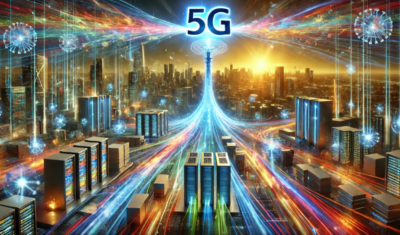The rollout of fifth-generation (5G) wireless technology marks a transformative shift in the landscape of information technology (IT) infrastructure. By offering unprecedented speed, reduced latency, and enhanced connectivity, 5G is poised to revolutionize how businesses and individuals interact with digital technologies. This article delves into the profound impacts of 5G on IT infrastructure, focusing on its potential to reshape data management, edge computing, network security, and industry-specific applications.

Enhanced Connectivity and Bandwidth
Breaking Speed Barriers: How 5G Redefines Connectivity
One of the most significant advantages of 5G technology is its ability to provide enhanced bandwidth and faster data transfer speeds. Compared to its predecessor, 4G, 5G offers speeds up to 100 times faster, facilitating real-time communication and data processing. This improvement necessitates a re-evaluation of existing IT infrastructure, as organizations must upgrade their hardware and software to fully leverage 5G’s capabilities. Data centers, for instance, need to be equipped with high-capacity storage solutions and optimized for handling increased traffic loads.
Evolution of Edge Computing
Edge Computing Revolution: The Power of Proximity
5G’s low-latency features have catalyzed the growth of edge computing, which involves processing data closer to its source rather than relying on centralized data centers. This approach significantly reduces the time required for data transmission and enhances the performance of latency-sensitive applications such as autonomous vehicles, smart cities, and augmented reality (AR) systems. As a result, IT infrastructure must evolve to accommodate decentralized computing models. This includes deploying edge servers, improving network resilience, and integrating artificial intelligence (AI) to optimize data processing and decision-making.
Challenges to Network Security
Securing the 5G Future: New Challenges and Solutions
The increased connectivity enabled by 5G also brings heightened security risks. With more devices and endpoints connecting to the network, the attack surface for cyber threats expands considerably. Traditional security measures may no longer suffice in the 5G era, compelling organizations to adopt advanced cybersecurity frameworks. These include zero-trust architectures, enhanced encryption protocols, and real-time threat detection systems powered by AI and machine learning. IT professionals must also address the challenges posed by the Internet of Things (IoT), where billions of interconnected devices amplify vulnerabilities.
Industry-Specific Transformations
Tailored Solutions: 5G’s Role in Industry Evolution
5G is expected to drive transformative changes across various industries, necessitating customized IT infrastructure solutions. In healthcare, for instance, the ability to transmit large volumes of data quickly enables telemedicine, remote surgeries, and real-time patient monitoring. Manufacturing industries benefit from smart factories powered by 5G, which facilitate seamless communication between machines and enable predictive maintenance. Similarly, the entertainment industry can harness 5G to deliver ultra-high-definition streaming and immersive virtual reality (VR) experiences. These advancements require IT systems that are robust, scalable, and tailored to industry-specific needs.
Economic and Environmental Considerations
Balancing Innovation with Sustainability in the 5G Era
While the adoption of 5G promises economic benefits through improved efficiency and innovation, it also poses challenges related to cost and energy consumption. Upgrading to 5G-ready infrastructure demands significant investment in new hardware, software, and training for IT personnel. Additionally, the energy requirements of 5G networks are higher than those of previous generations, raising concerns about sustainability. Organizations must therefore explore green IT practices, such as optimizing energy usage and investing in renewable energy sources, to mitigate the environmental impact of 5G deployment.
The Road Ahead
5G and the Future: Preparing for a Connected Tomorrow
As 5G continues to gain traction globally, its impact on IT infrastructure will only deepen. Organizations must proactively adapt to this new paradigm by investing in cutting-edge technologies, enhancing cybersecurity measures, and rethinking traditional approaches to network management. Policymakers, too, have a role to play in facilitating the transition by promoting research and development, establishing standards, and addressing regulatory challenges.
In conclusion, the advent of 5G represents a watershed moment for IT infrastructure. By embracing the opportunities and addressing the challenges presented by this technology, businesses can unlock new possibilities and position themselves for sustained success in an increasingly connected world.
By – Mritunjay Pandey – IMS Ghaziabad (Lal Kuan)

